Bruce Arena 2.0: How USMNT's manager tackles social media and the digital age

DENVER — Last November, when Bruce Arena began his second tenure coaching the U.S. men’s national team, he had a conversation with Neil Buethe, U.S. Soccer’s director of communications.
“Should I get on Twitter and do those things?” asked Arena, 65, who has been coaching for four decades.
“Do you want to?” Buethe replied.
“Not really.”
“Then you probably shouldn’t do it.”
Buethe’s reasoning was straightforward: If a head coach doesn’t want to engage personally on social media, then it won’t be authentic and the benefit will be lost. Let’s make one thing clear: An unvarnished Bruce Arena on Twitter would be a fantastic thing if it captured his serial wisecracks, biting sarcasm and Howard Stern-style worldview. Part of me wishes he had a Twitter assistant following him around just to post things he was saying all day.
Alas, that’s not happening. Will we ever see Arena with his own Twitter or Facebook account? “Definitely not,” Arena told SI.com on Wednesday ahead of Thursday’s World Cup qualifier against Trinidad and Tobago (7:50 p.m. ET, FS1, Unimás). “I don’t really care to know what other people are doing, nor do I think they need to know what I’m doing. If they want me to know what they’re doing, they’ll let me know.”
In-need U.S. men's national team re-enters Bruce's unchanged arena
The media and communications landscape is a changed place in 2017 compared to 1998, when Arena first became the U.S. men’s coach, and how Arena deals with the media and the public is a significant part of his job and a component of U.S. Soccer’s growth in popularity around the country.
Arena has been willing to try some new things, like taking questions from supporters on Facebook Live videos shot in his office in Carson, Calif., though he wasn’t a huge fan of the results.
“I feel like I’m underground hiding from the police or something doing an interview,” he cracks.
But during a training camp like this one, Arena is willing to do plenty of interviews with a media contingent that has grown in leaps and bounds since his first time in charge.
How has what Arena does with the media changed this time around?
“I’m not sure it’s what I do with the media. It’s what the media does with me,” Arena says. “I haven’t spent any time thinking about this, but when I started in 1998 the Internet existed and there were emails. I’m not sure there were text messages then. But there began to be more coverage on the Internet and stories that were obviously produced quicker than they are in the print media. So therefore people started becoming experts a lot quicker.
“And the broadcast media was increasing,” he continues. “Today it’s crazy. Today anything you say can be instantly reported. There’s a lot of good, there’s a lot of bad. Overall I think it’s fantastic for our sport, whether you agree with it or not, because our sport is now more exposed. I find it incredibly interesting how people with probably not that great a background in this sport can produce volumes of information and opinions on how things are supposed to be done that is so ridiculous it’s almost comical. I laugh at it sometimes, but overall it’s good.
“And listen, when you sign up for this job, I’m a target. I know that. It doesn’t bother me in the least. It’s all part of the job.”
Altitude, quick turnaround add to USMNT's pressing World Cup qualifying window
Buethe and Michael Kammarman, the USMNT press officer, say Arena has been willing to participate in most of the media requests that come their way, which they vet and then bring to him. During this camp, for instance, Arena has met almost daily with the media after training sessions. He has also done one-on-one sit-down interviews with CBS’s 60 Minutes (for an upcoming story on Christian Pulisic), this one for SI.com and rights-holder interviews with Univision and a behind-the-scenes video series from Fox Sports that’s following the team as it goes through qualifying for the World Cup.
“I don’t want me to always be the voice of the team,” Arena says. “I’d like the players to be the voice, or people in U.S. Soccer. It doesn’t just need to be me, so I don’t go out of my way to do any of this stuff. I think there’s enough for everybody.”
Arena says he doesn’t have any major issues with having cameras behind the scenes with the team if they’re just following the team’s daily preparations.
“There’s no point in having a camera behind closed doors with us ripping a player on something,” he says. “And we don’t necessarily rip them, but we do give them constructive criticism.” So while it’s not quite to the level of HBO’s "Hard Knocks," Arena thinks that type of cinema verite has its own problems.
“I’ve talked to some of those people that were part of 'Hard Knocks,'” Arena says. “Whenever you’re on camera, you fake it. In MLS, they wanted us miked and on camera before the game talking to the team. And it interferes with your ability to communicate with your team, because the message then becomes something different. Because you’re not going to say before kickoff: ‘Remember what we talked about, you’ve gotta get after this guy, he stinks.’ Or something like that. That would be not a good thing to have public. So then your message at halftime or before the game is, ‘Let’s go, let’s win,’ or something like that. Pretty bland stuff.”
U.S. manager Bruce Arena through the years
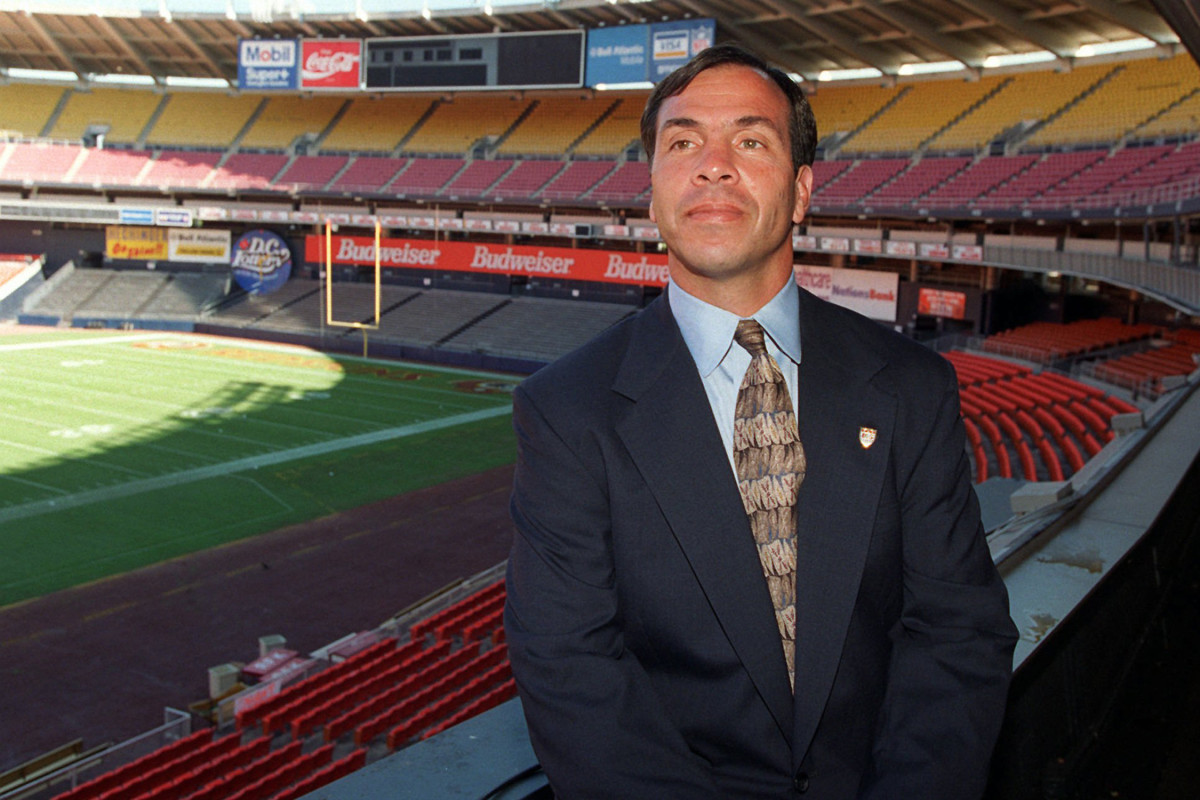
Bruce Arena poses at RFK Stadium in Washington, D.C., in October 1995 after being named coach of the U.S. Olympic team.
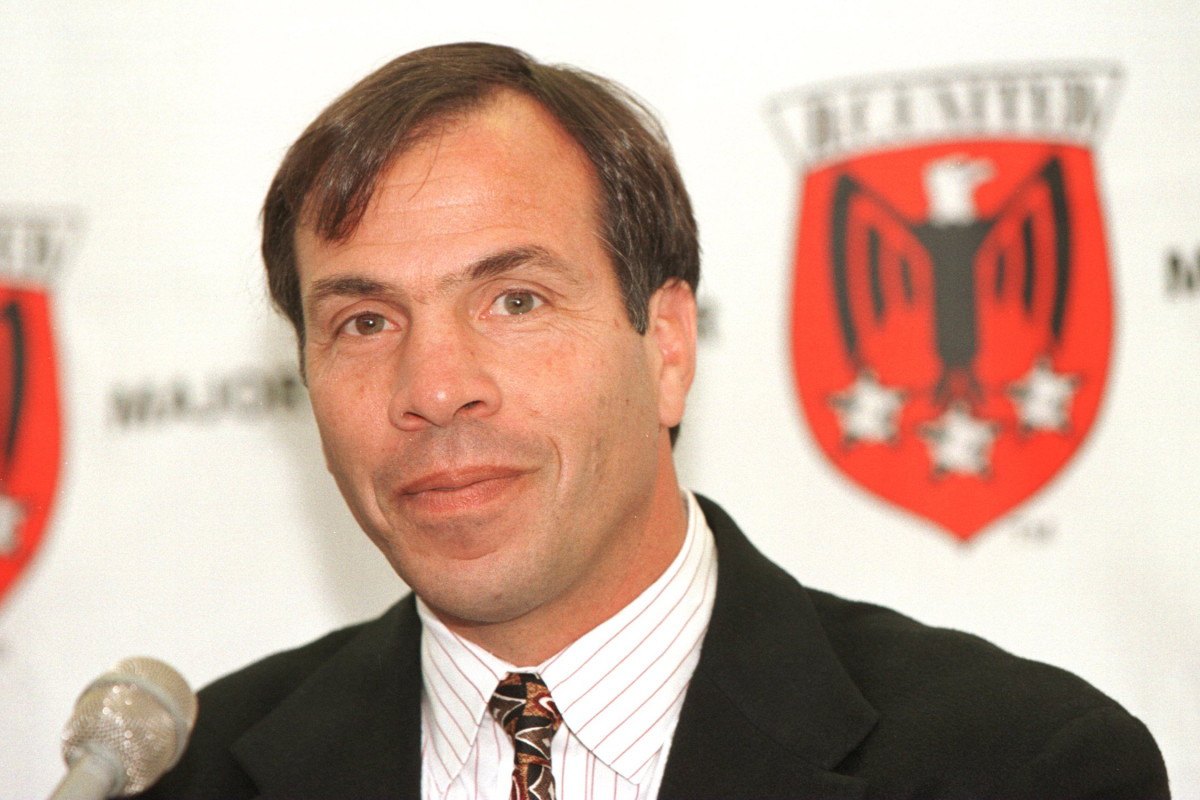
Bruce Arena talks at a February 1996 press conference with D.C. United, the club he guided to MLS Cup titles in the league's first two years.
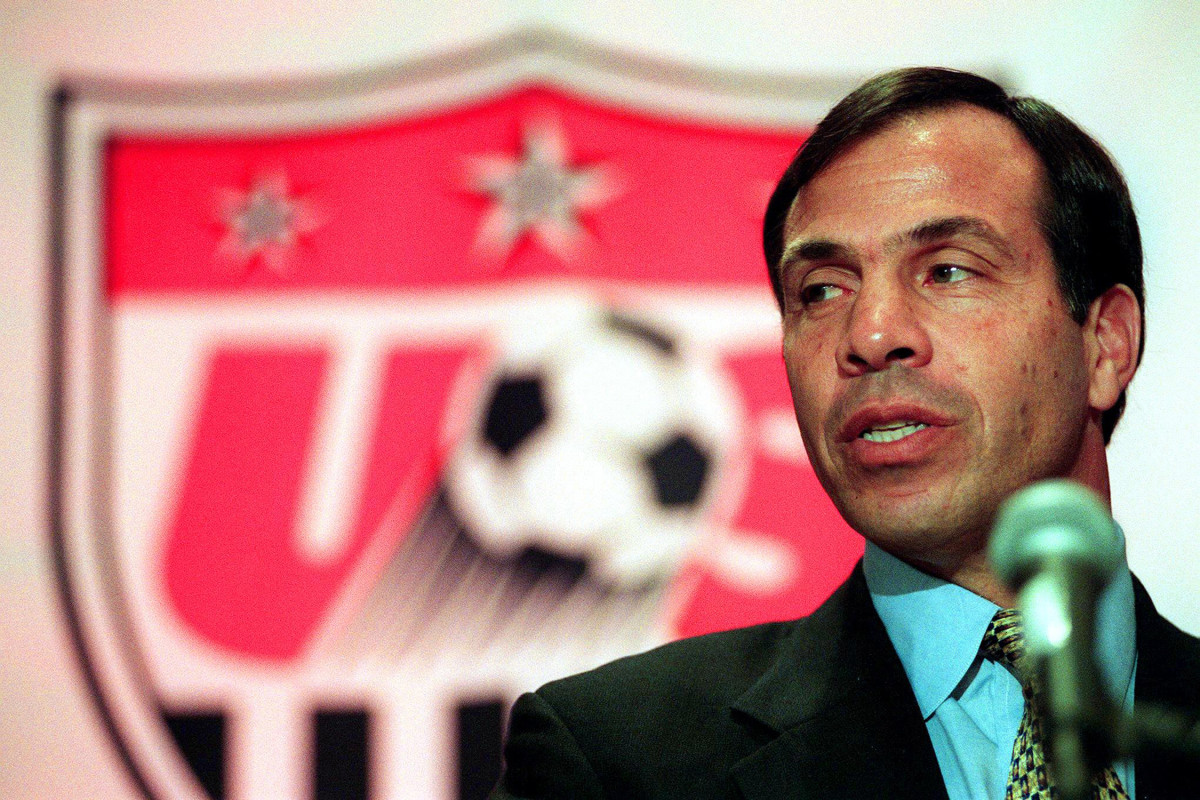
Bruce Arena is introduced as the head coach of the U.S. men's national team in October 1998 at a press conference in New York.
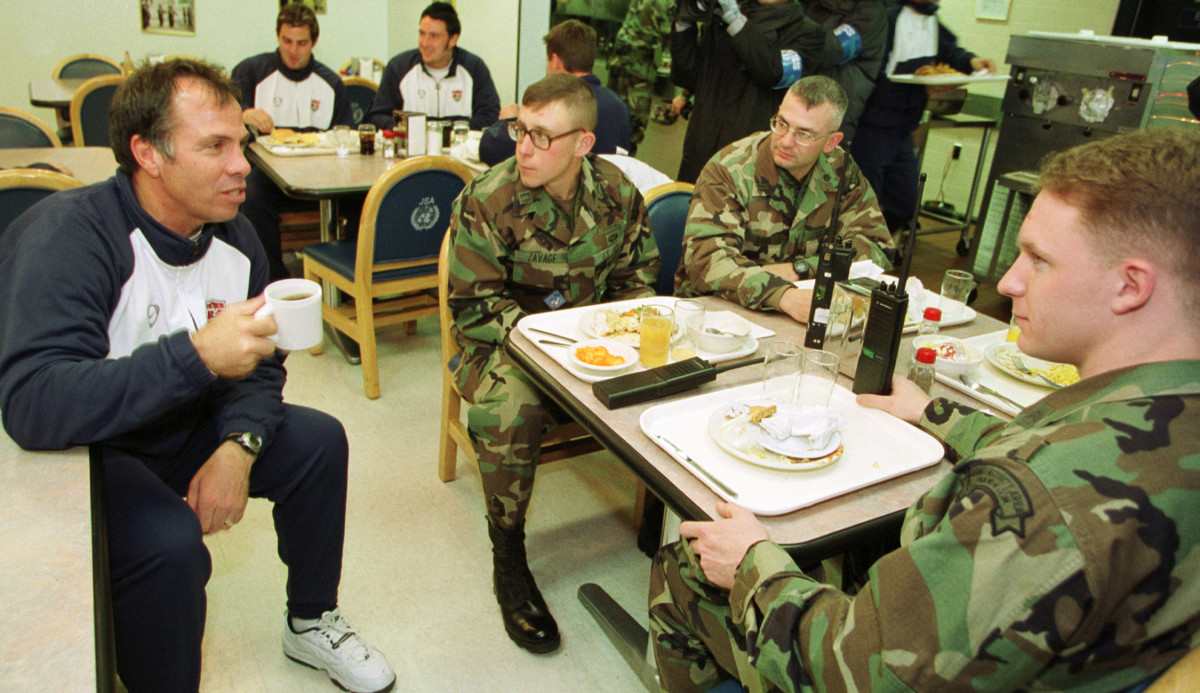
Bruce Arena talks with soldiers at a U.S. military base north of Seoul, South Korea, in December 2001 prior to a friendly against South Korea in preparation for the 2002 World Cup.
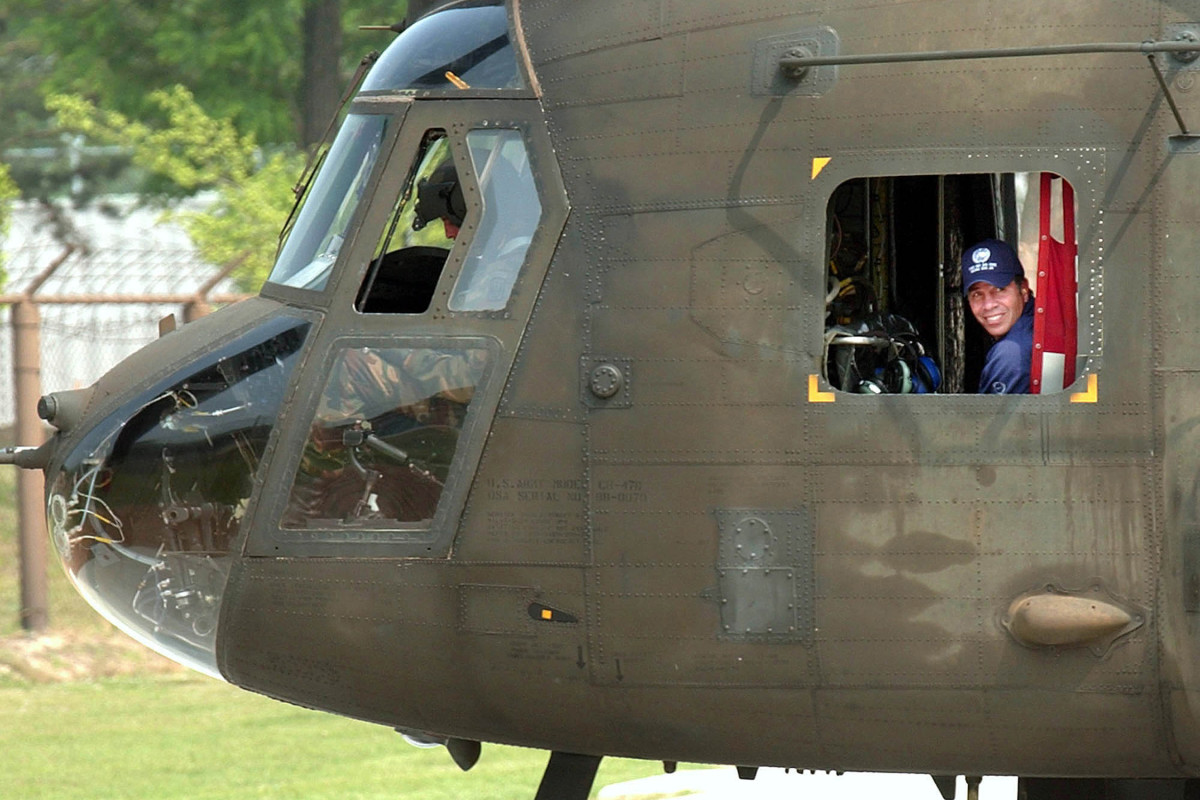
Bruce Arena looks out the window of a U.S. Army helicopter as the pilot prepares to take off from Camp Liberty Bell following the team's visit to the demilitarized zone between South Korea and North Korea on May 31, 2002, in Panmunjon, South Korea.
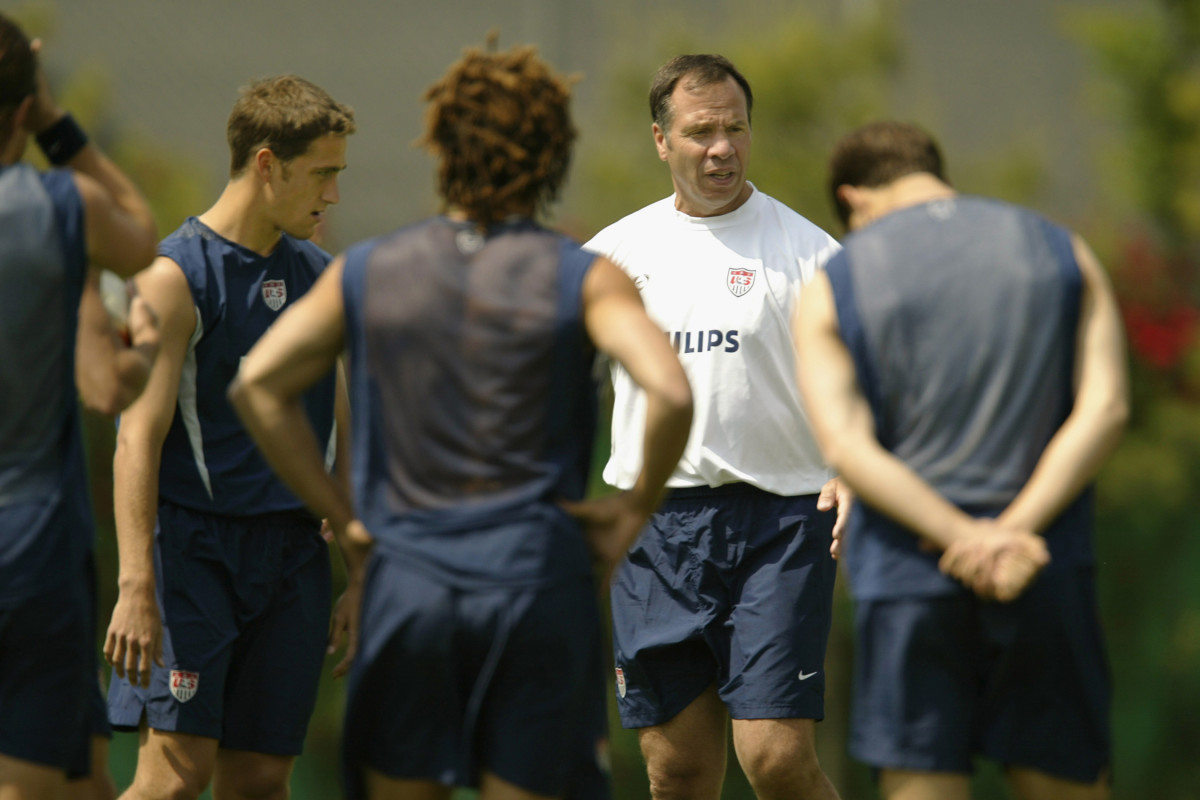
Bruce Arena holds a U.S. training session at the Misari Football Center in Seoul, South Korea on May 29, 2002 prior to the start of the World Cup.
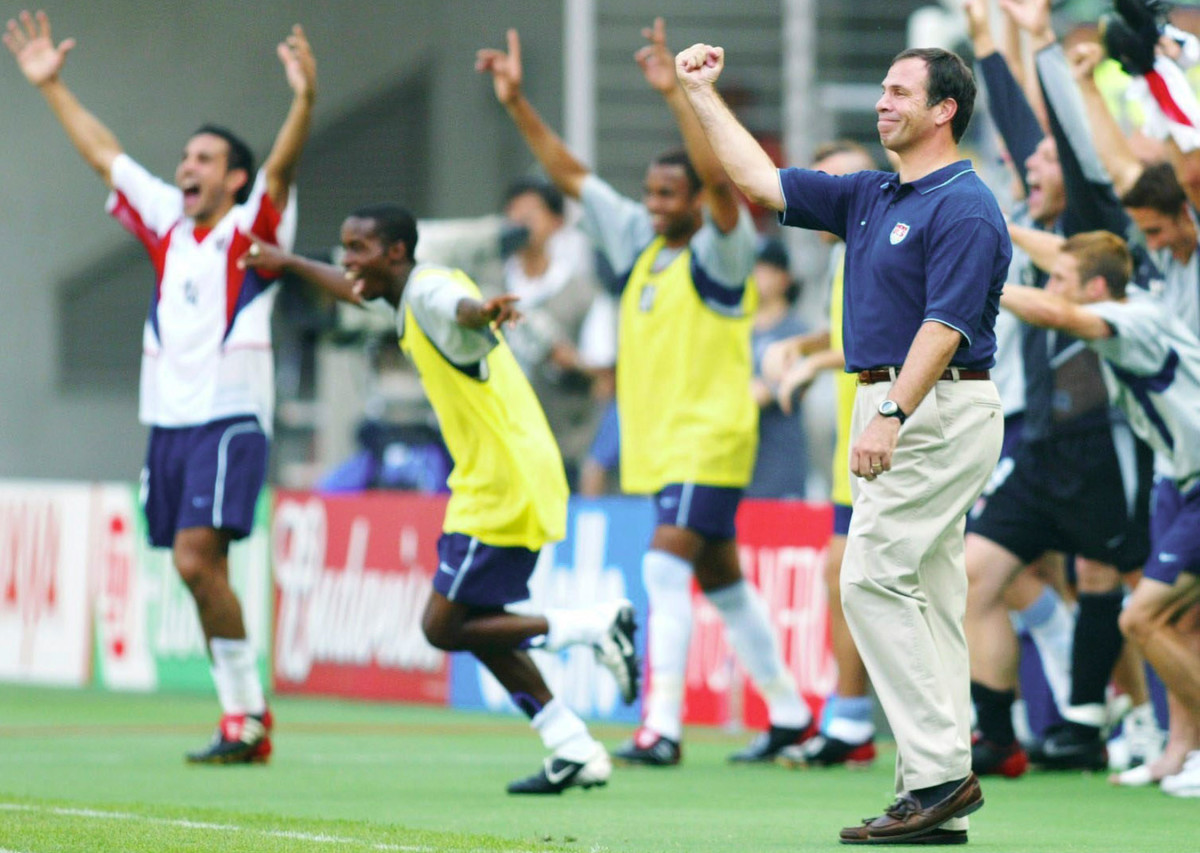
Bruce Arena gives a fist pump as U.S. players celebrate during the USA's landmark 2-0 win over Mexico in Jeonju, South Korea, in the round of 16 at the 2002 World Cup.
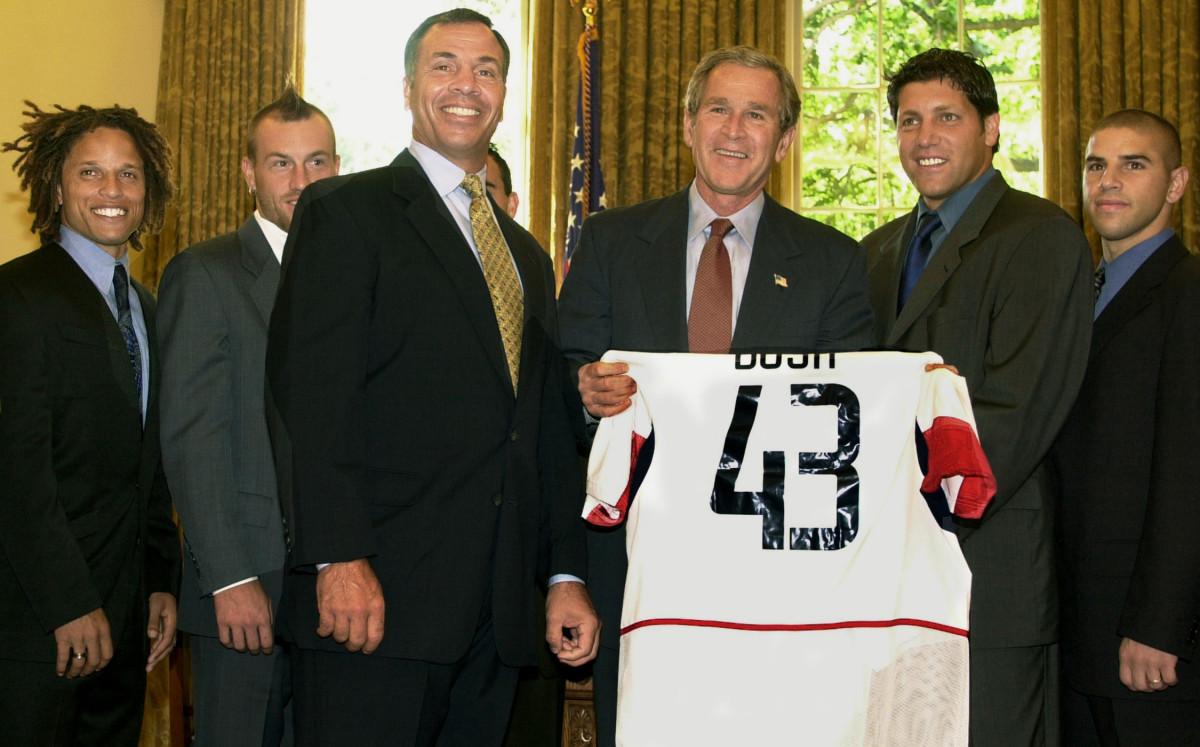
Bruce Arena and the 2002 USA World Cup team present a jersey to President George W. Bush in the Oval Office at the White House.
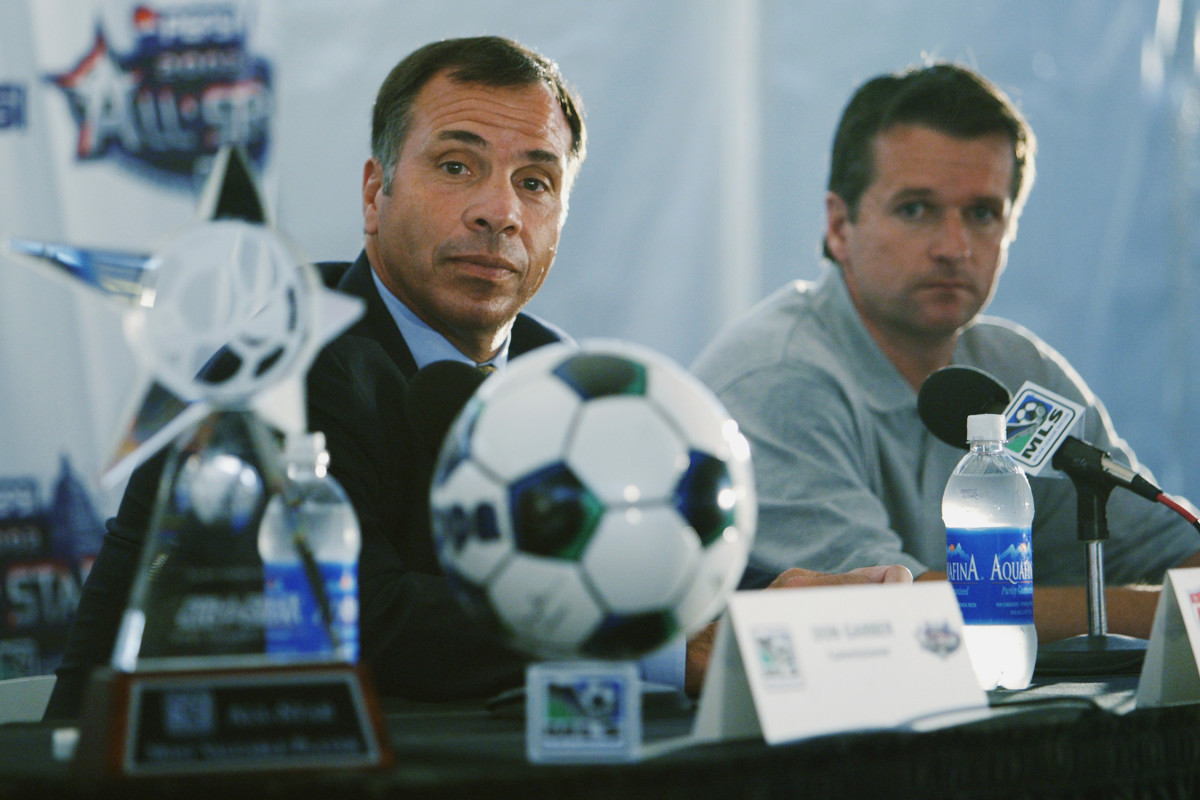
Bruce Arena, coach of the U.S., and Frank Yallop, coach of the MLS All-Stars, answer questions at the only USA vs. MLS All-Star Game in league history, which MLS won 3-2 at RFK Stadium in Washington, D.C., in August 2002.
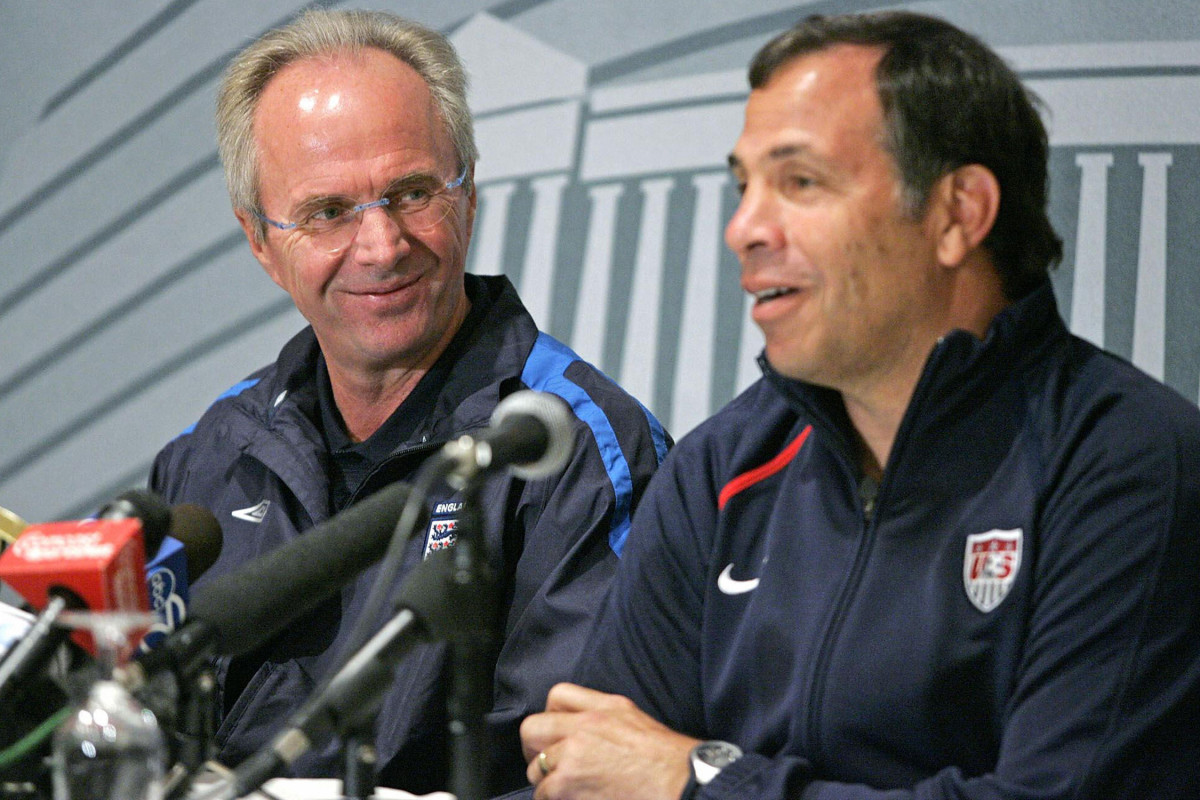
Bruce Arena and England manager Sven-Goran Eriksson answer questions at a pre-friendly press conference in Chicago in May 2005.
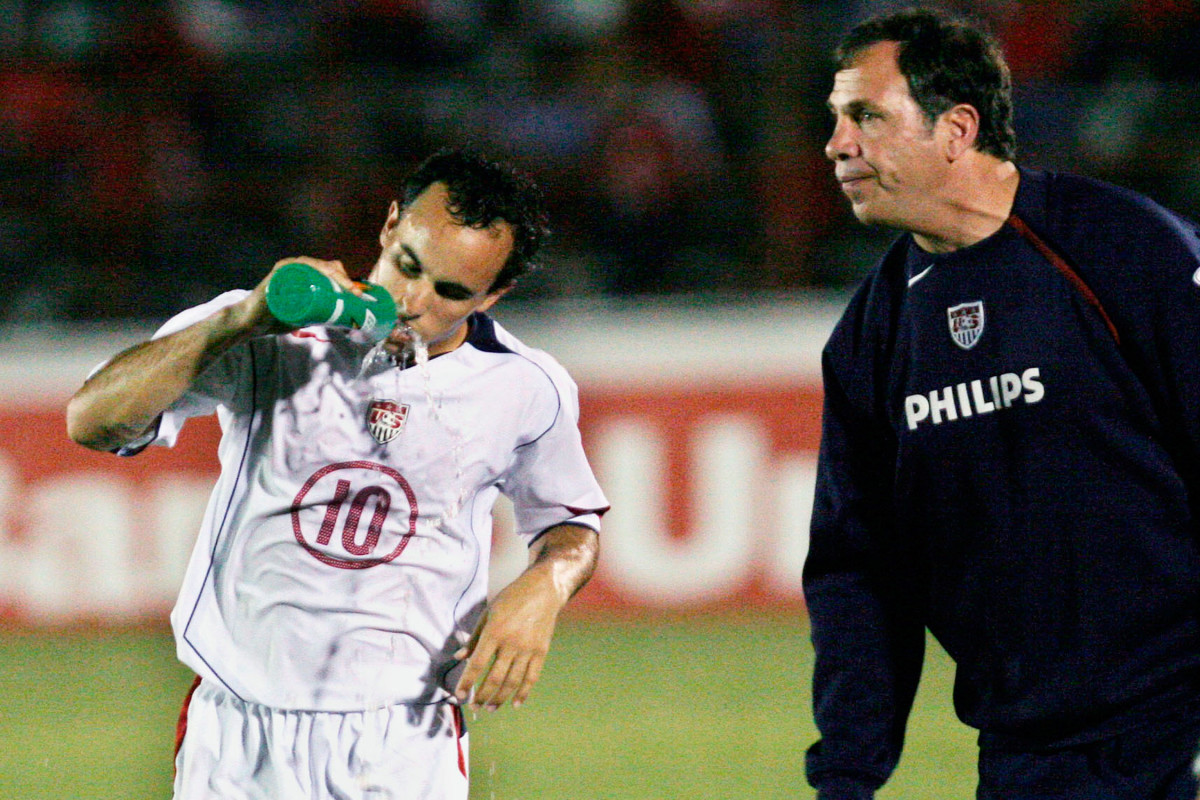
Bruce Arena gives instructions to Landon Donovan during the USA's World Cup qualifying match against Panama at Rommel Fernandez Stadium in Panama City on June 8, 2005.
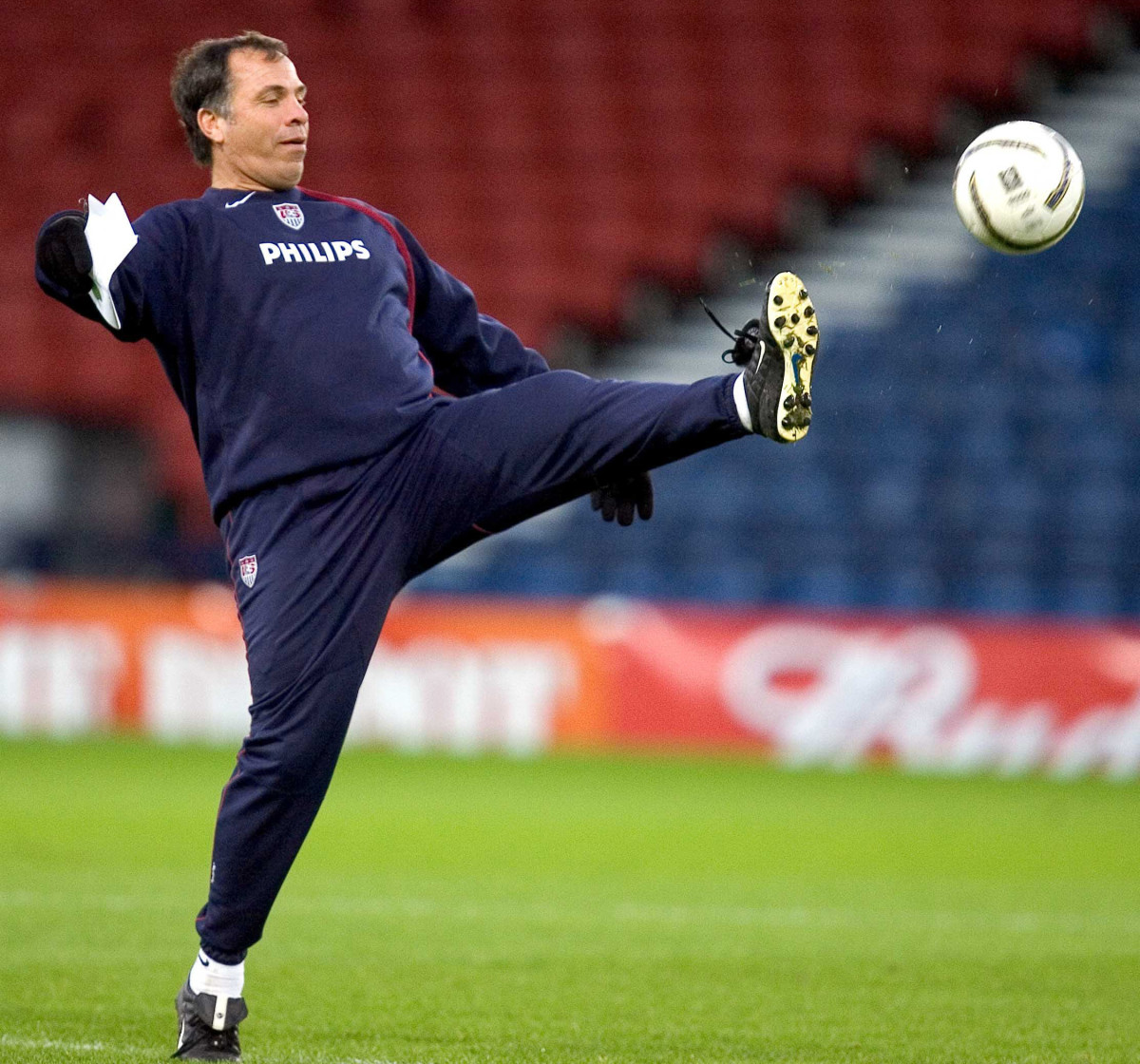
Bruce Arena shows off his agility during a U.S. training session in Glasgow prior to a November 2005 friendly against Scotland.
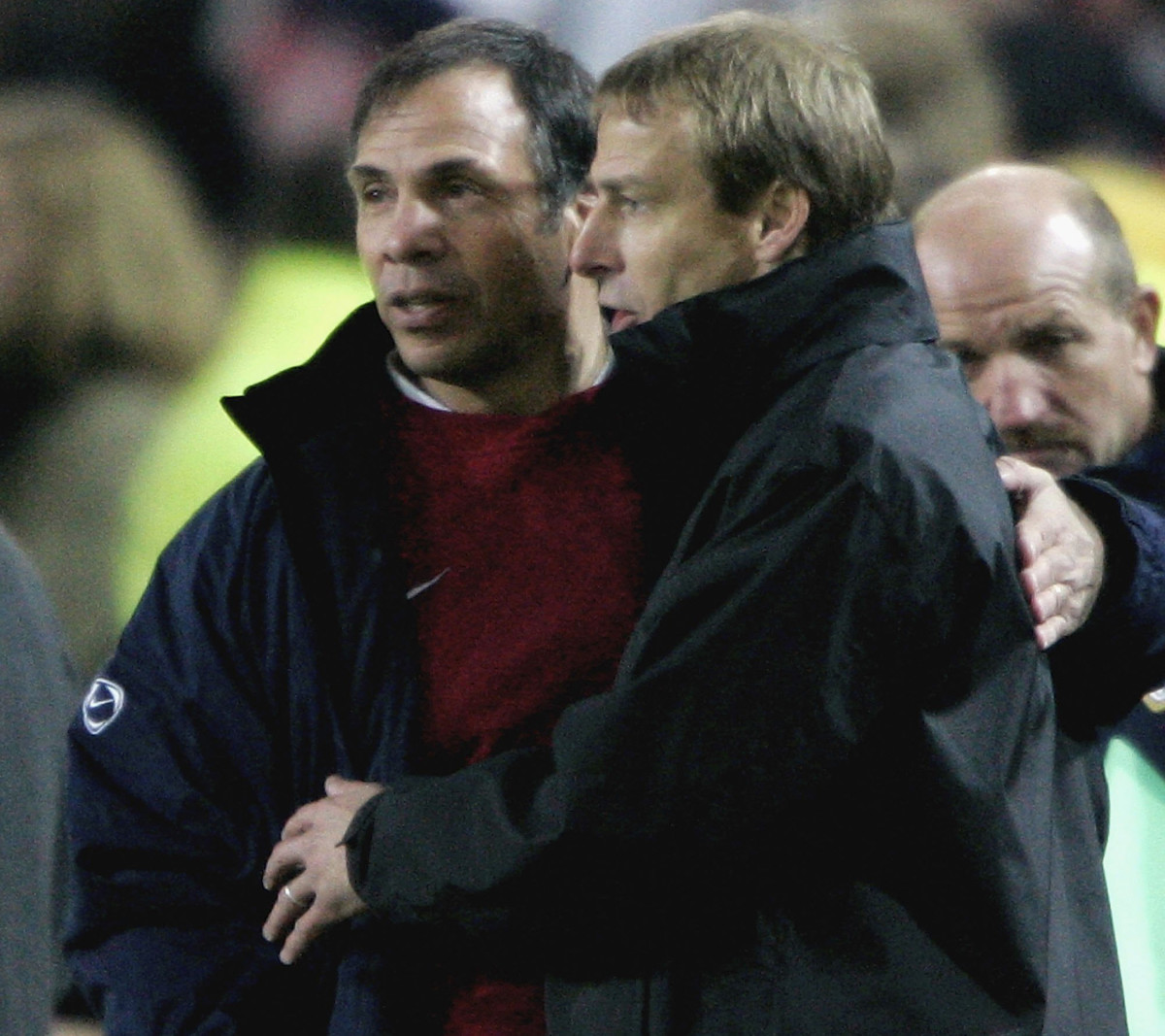
Bruce Arena shares a hug with Jurgen Klinsmann during a March 2006 friendly between the USA and Germany in Dortmund. Their paths would cross later in life...
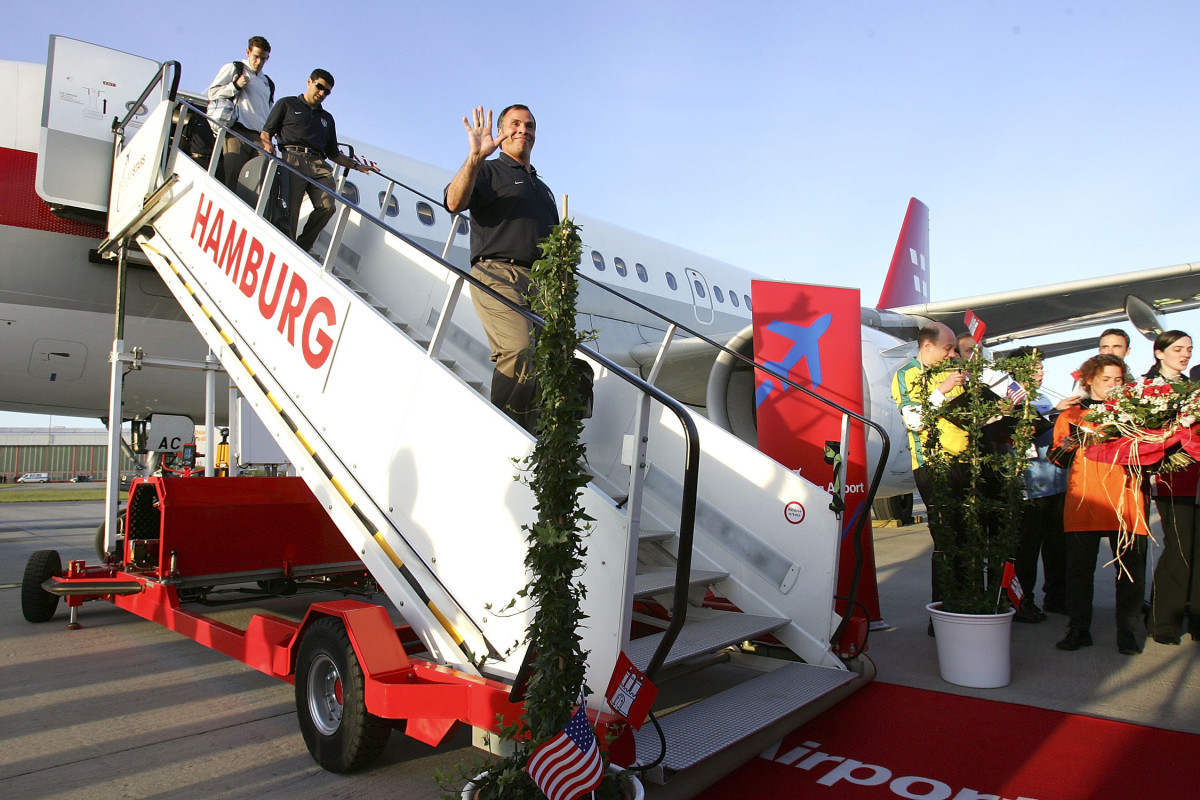
Bruce Arena steps off the plane in Hamburg, Germany, where the USA arrives for the 2006 World Cup.
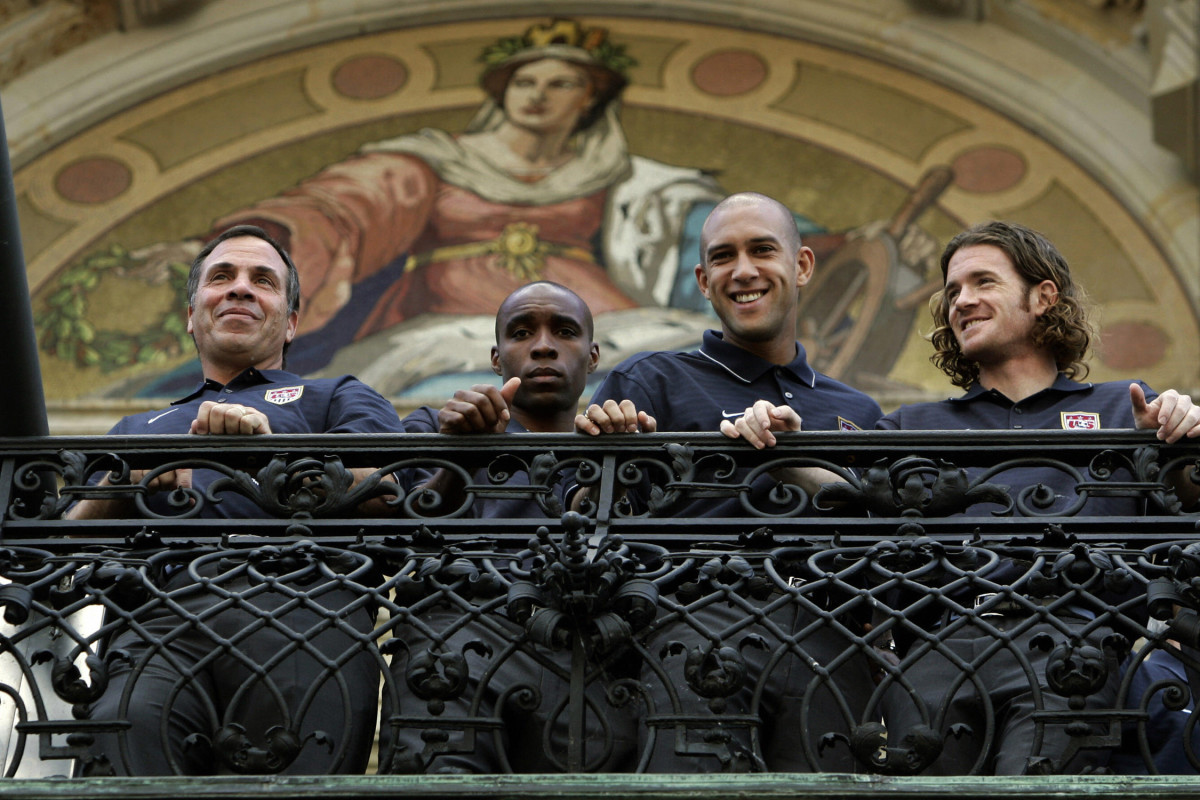
Bruce Arena, Eddie Pope, Tim Howard and Josh Wolff are welcomed by the mayor of Hamburg at The Ratthaus in June 2006 ahead of the the Americans' participation in the World Cup.
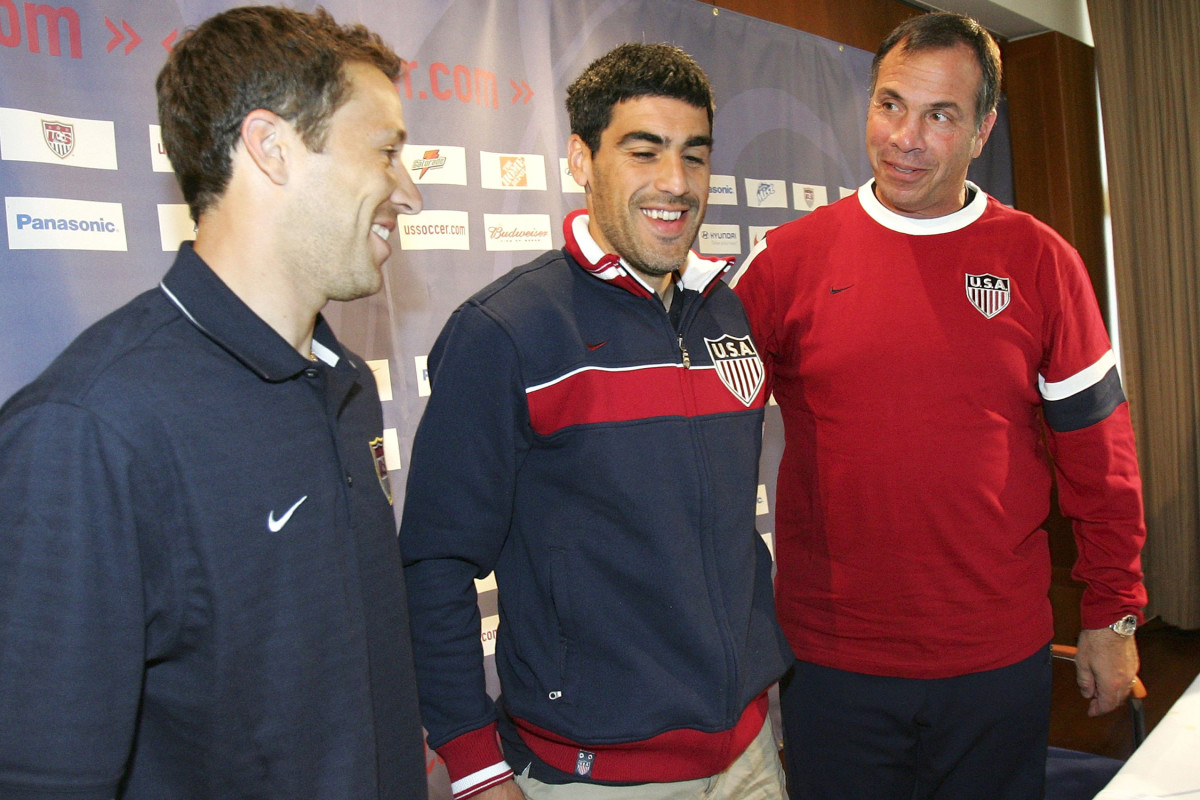
Bruce Arena stands with Claudio Reyna and Steve Cherundolo after a press conference in Hamburg, Germany leading up to the 2006 World Cup opener.
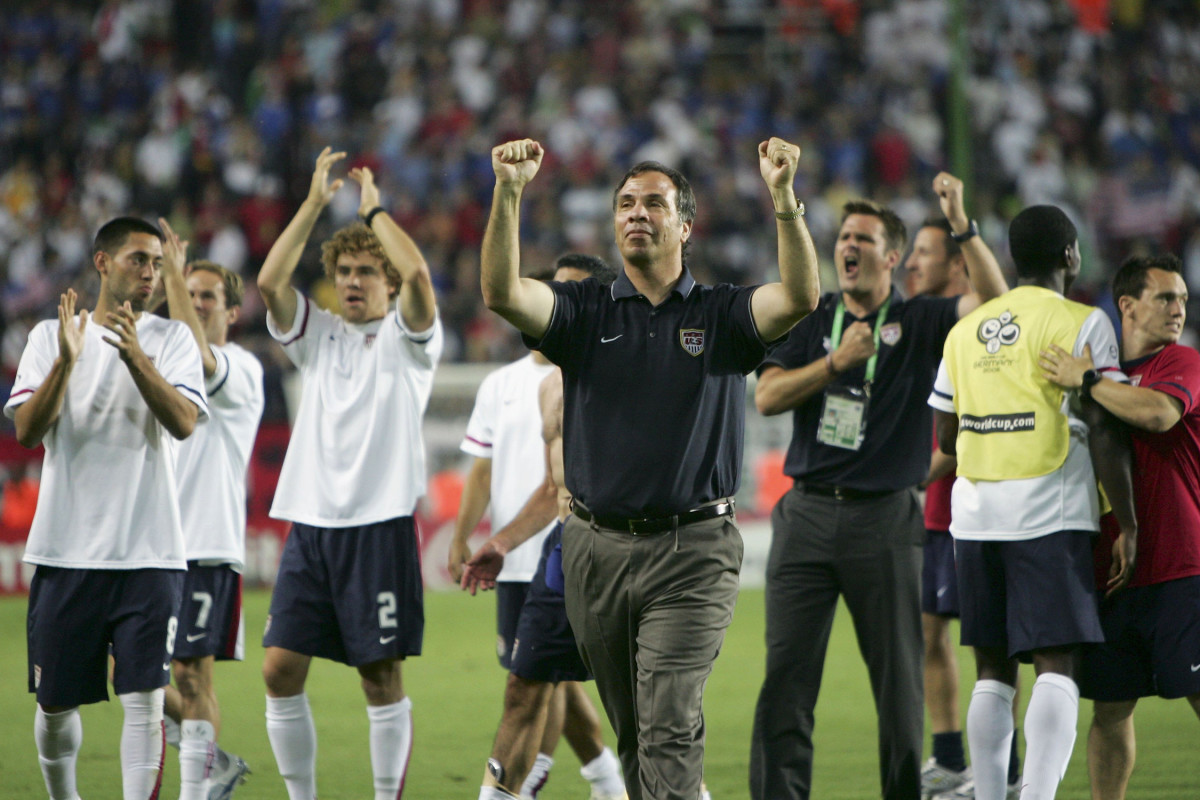
Bruce Arena celebrates after his USA's 1-1 draw against eventual champion Italy after a hard-fought World Cup group-stage match at Fritz-Walter Stadium on June 17, 2006 in Kaiserslautern, Germany.
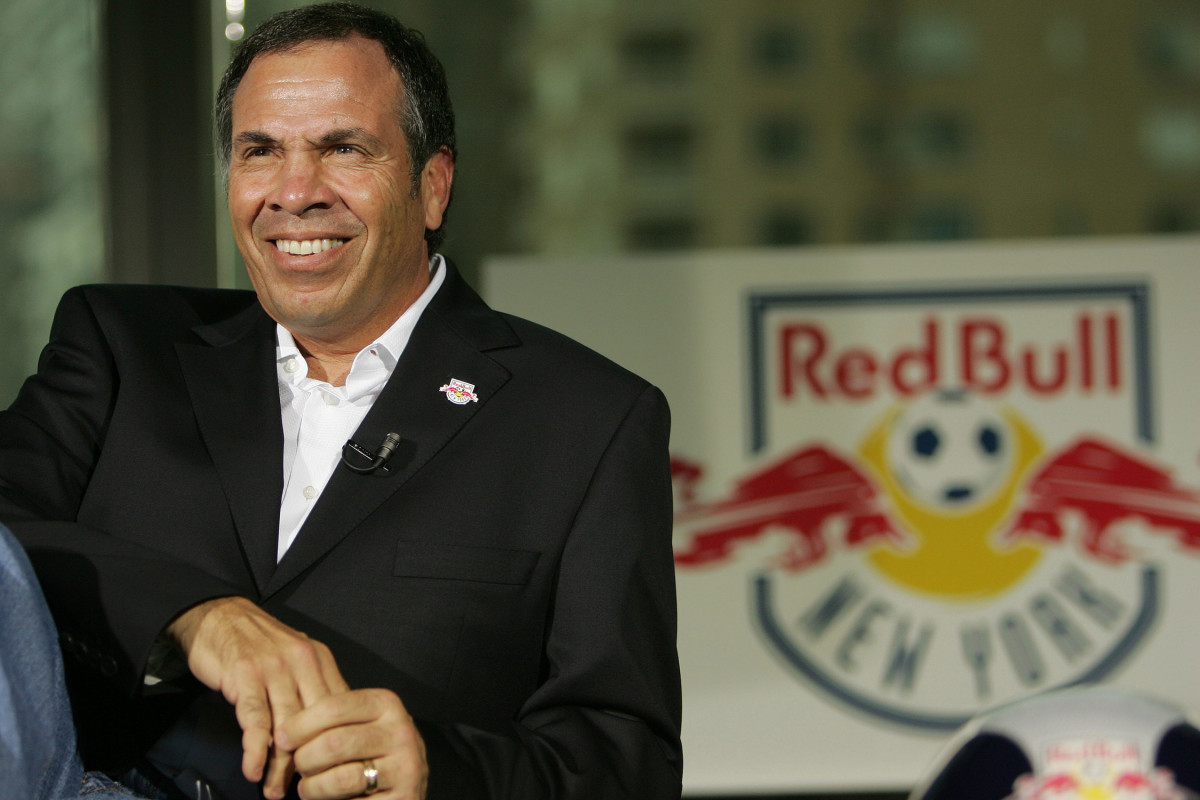
Bruce Arena is introduced as manager of the New York Red Bulls in July 2006 following his dismissal as U.S. national team coach.
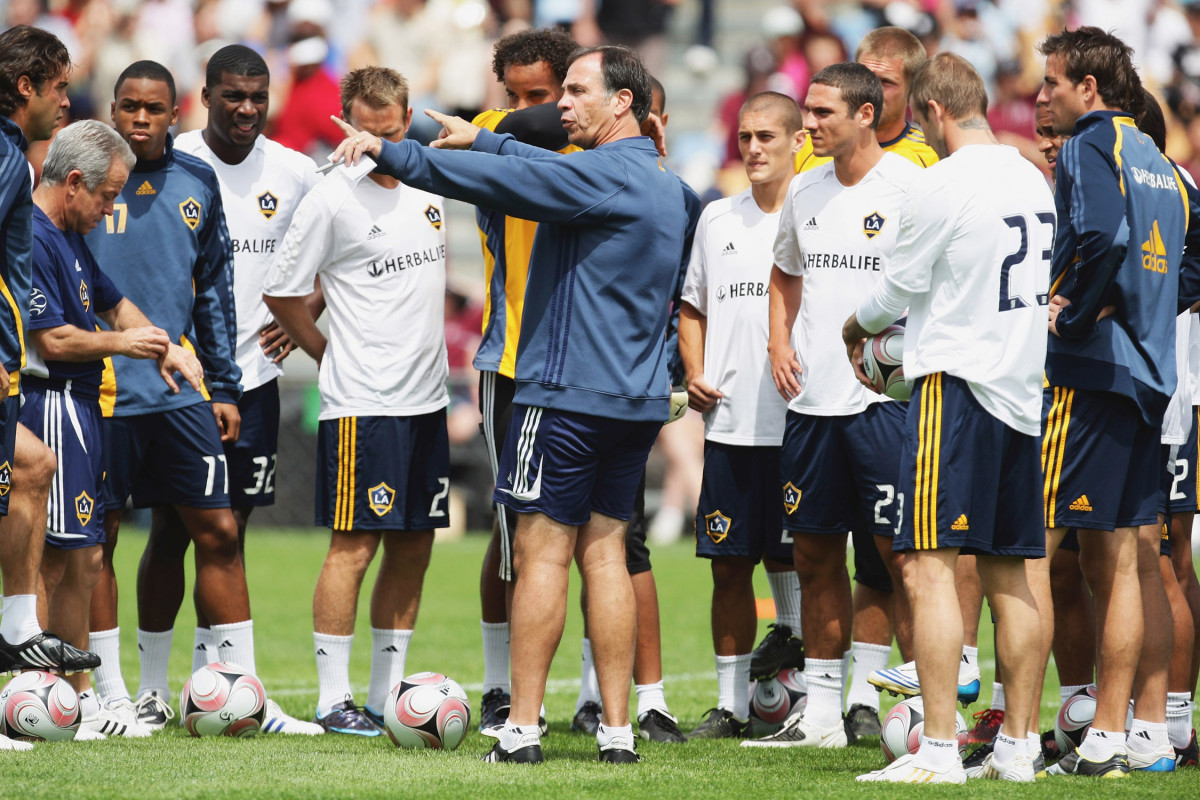
Bruce Arena leads an LA Galaxy postseason training session at Mt. Smart Stadium in Auckland, New Zealand, in December 2008 after taking over as manager midway through the 2008 MLS season.
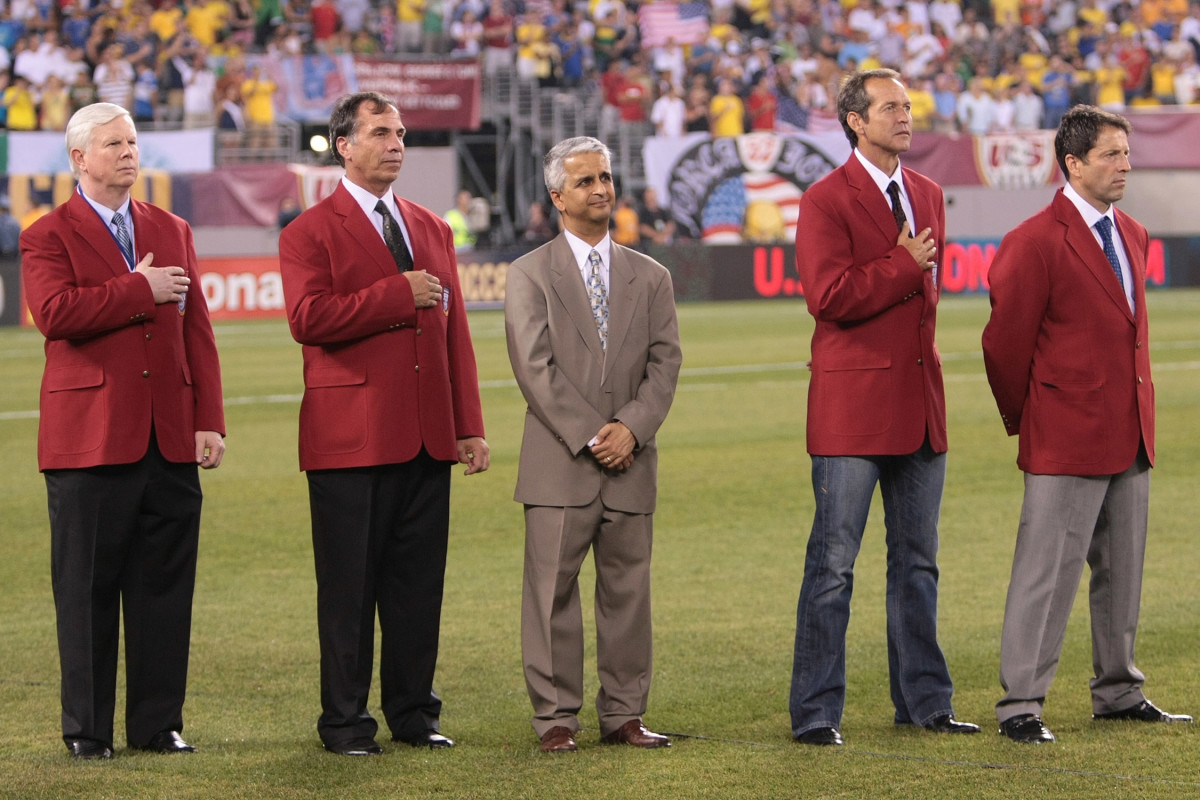
Bruce Arena is one of four National Soccer Hall of Fame inductees honored on the field during the USA's friendly vs. Brazil in August 2010, standing with Kyle Rote Jr., Sunil Gulati, Thomas Dooley and Preki Radosavljević.
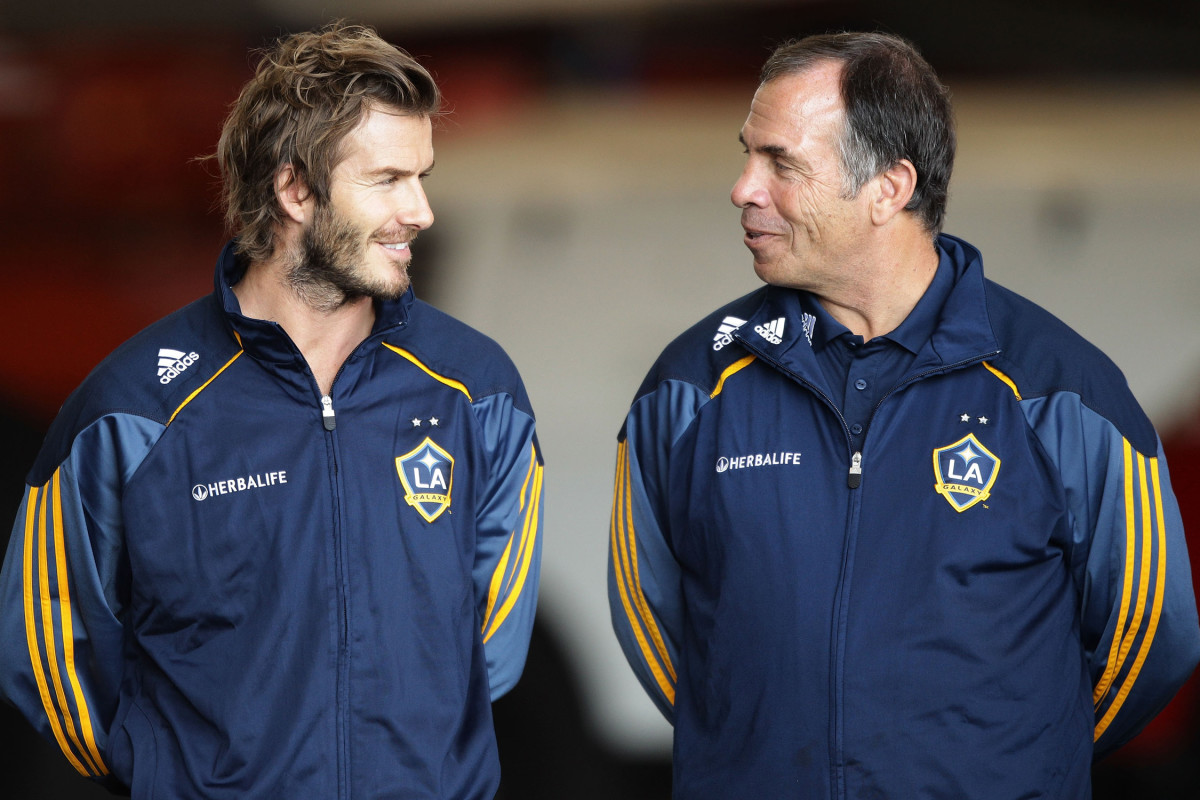
David Beckham and Bruce Arena share a joke at Sydney International Airport on November 25, 2010, during a postseason trip to Sydney, Australia.
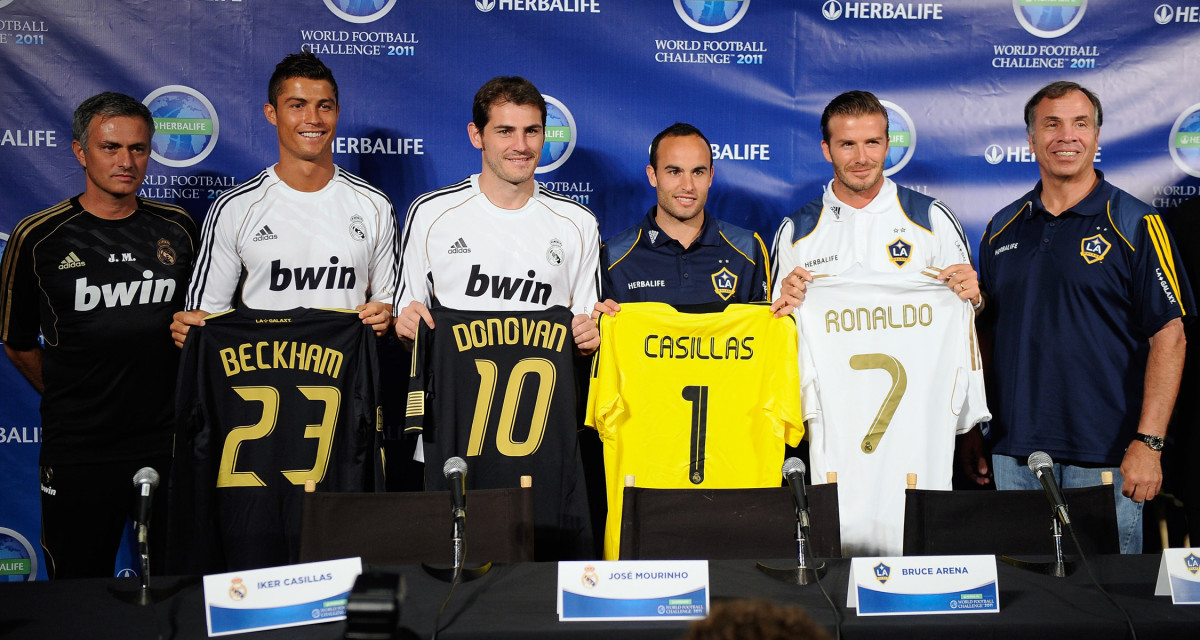
At a star-studded event in July 2011, Real Madrid's Cristiano Ronaldo, Iker Casillas and Jose Mourinho pose with the LA Galaxy's Landon Donovan, David Beckham and Bruce Arena to announce the Herbalife World Football Challange 2011 friendly tournament in which the Galaxy and Real Madrid played one another.
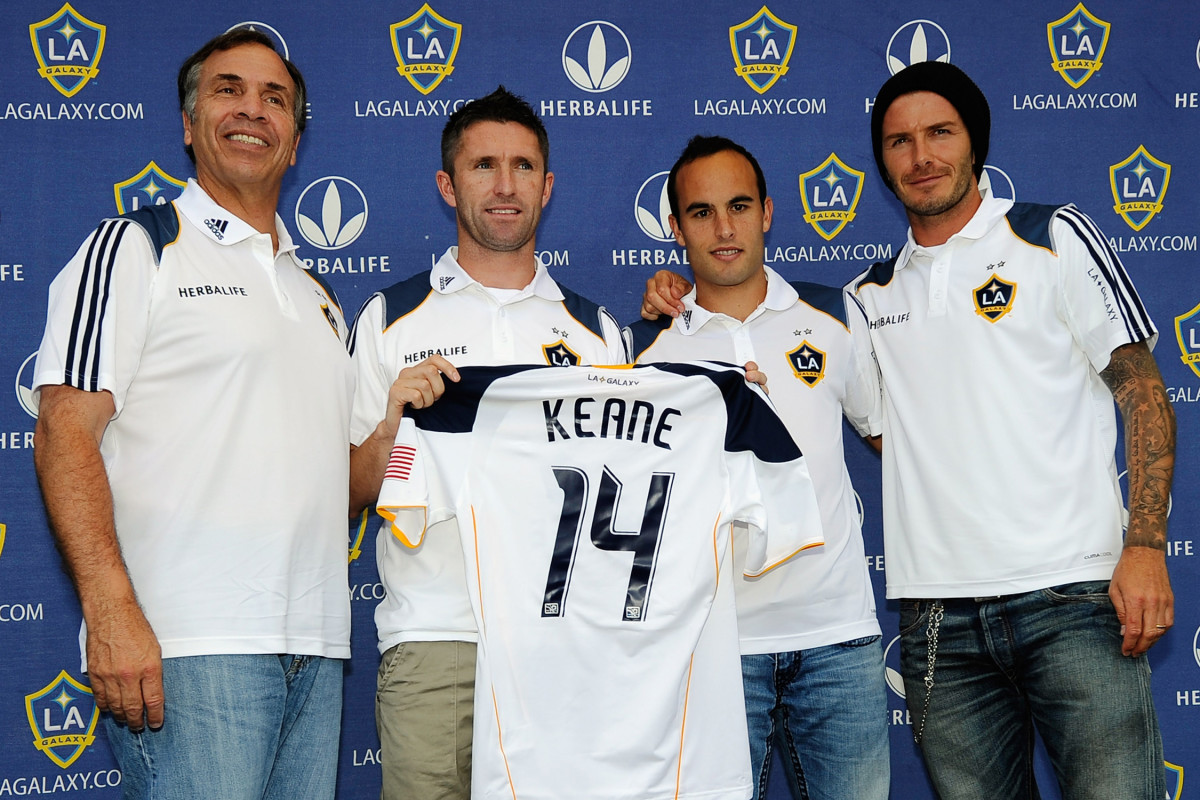
With help from Landon Donovan and David Beckham, Bruce Arena introduces Robbie Keane as the LA Galaxy's third Designated Player in August 2011.
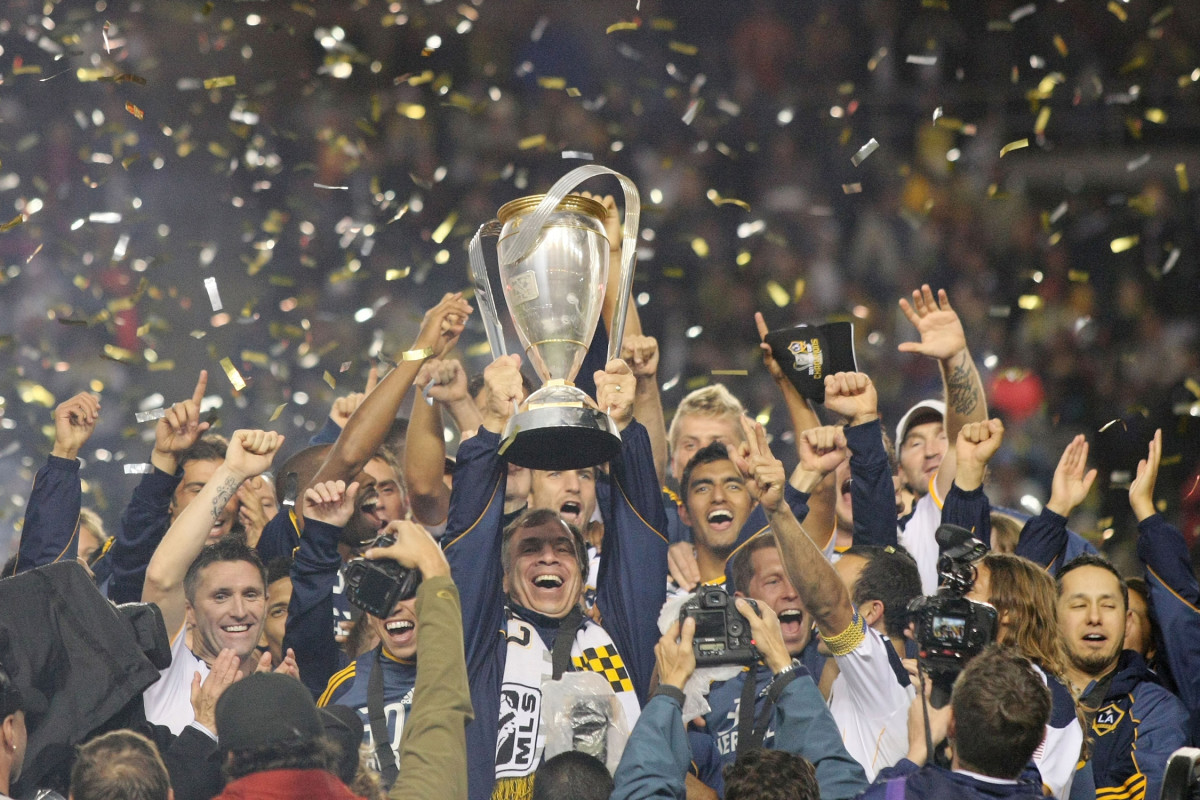
Bruce Arena hoists the MLS Cup after the LA Galaxy's 1-0 win over the Houston Dynamo in 2011, the first of three titles he would win with the club.
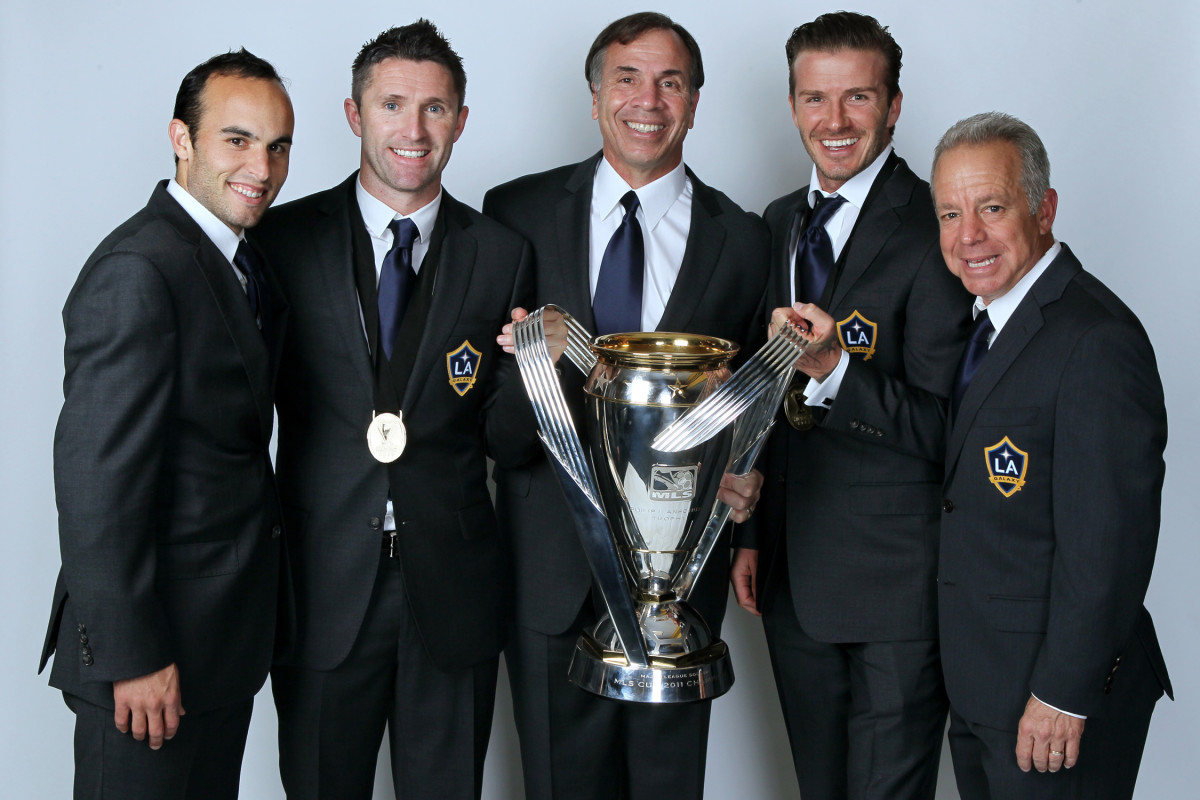
Bruce Arena holds the MLS Cup trophy in between Landon Donovan, Robbie Keane, David Beckham and Dave Sarachan after the 2011 triumph over the Houston Dynamo.
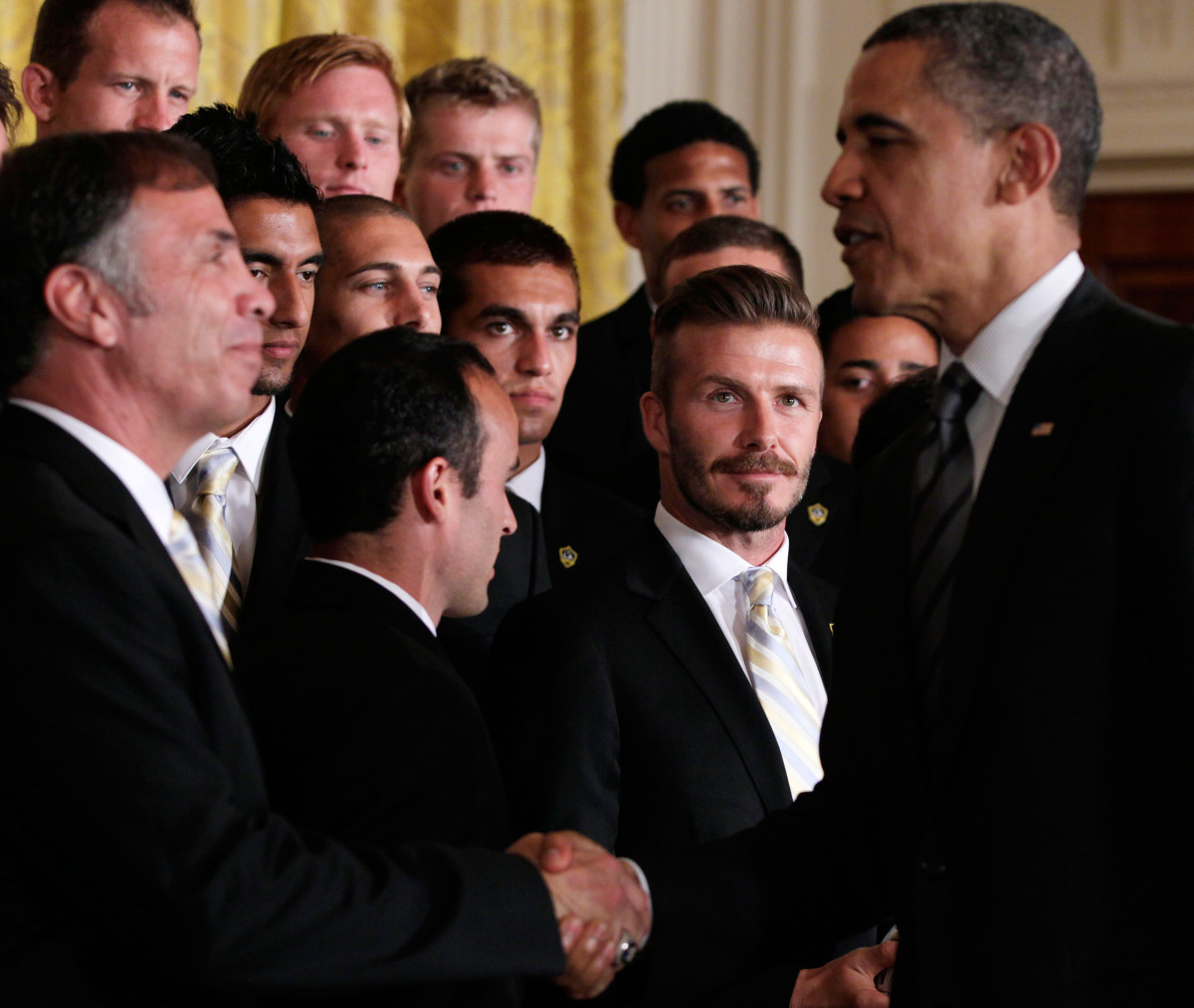
Bruce Arena shakes hands with President Barack Obama at the White House during a 2012 ceremony honoring the 2011 MLS Cup champion LA Galaxy.
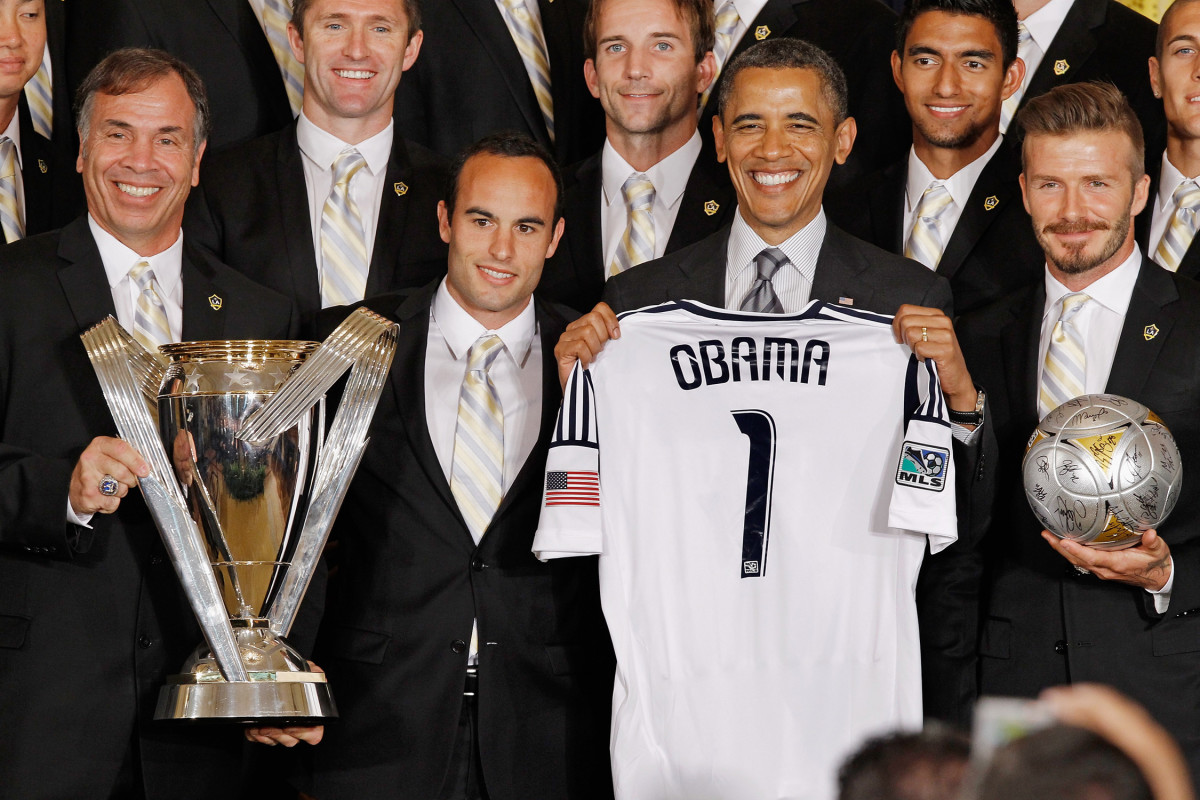
Bruce Arena, Landon Donovan, President Barack Obama and David Beckham are front and center as the LA Galaxy celebrate their 2011 MLS Cup title at the White House.
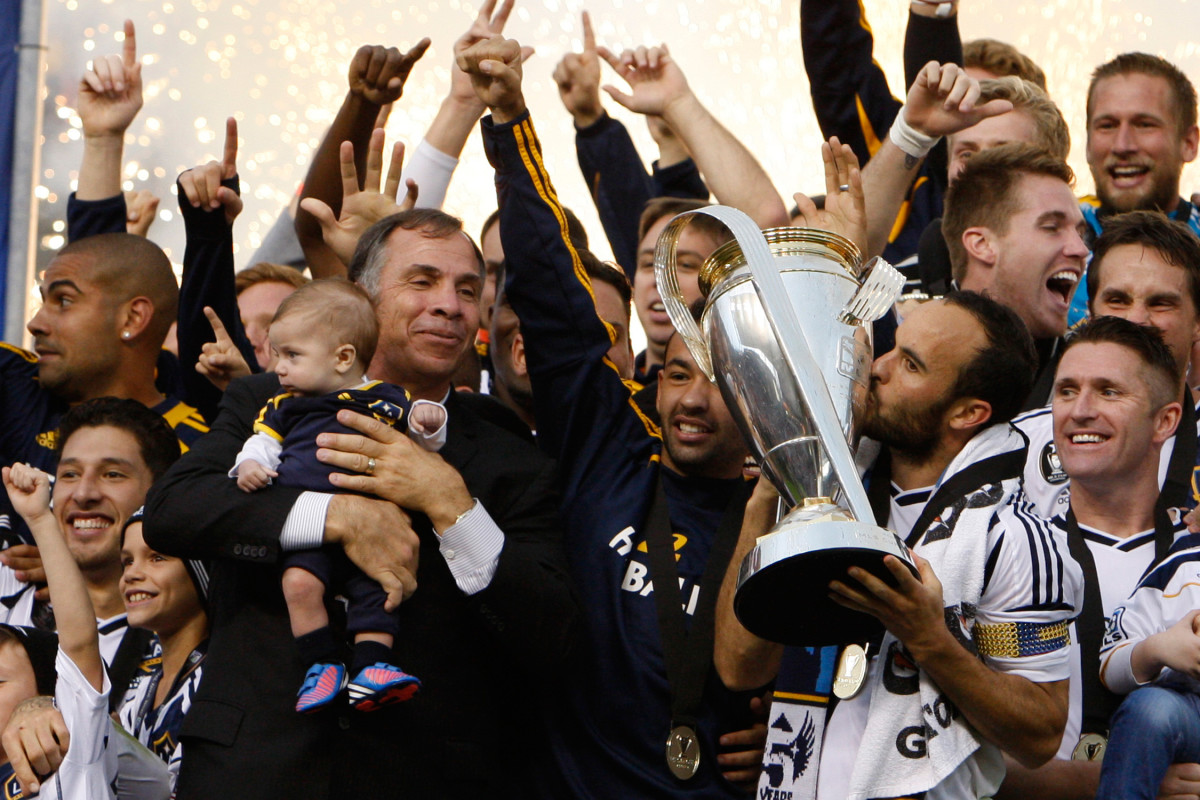
Bruce Arena holds one of his grandsons and looks on as Landon Donovan kisses the MLS Cup trophy after the LA Galaxy beat the Houston Dynamo for the 2012 title.
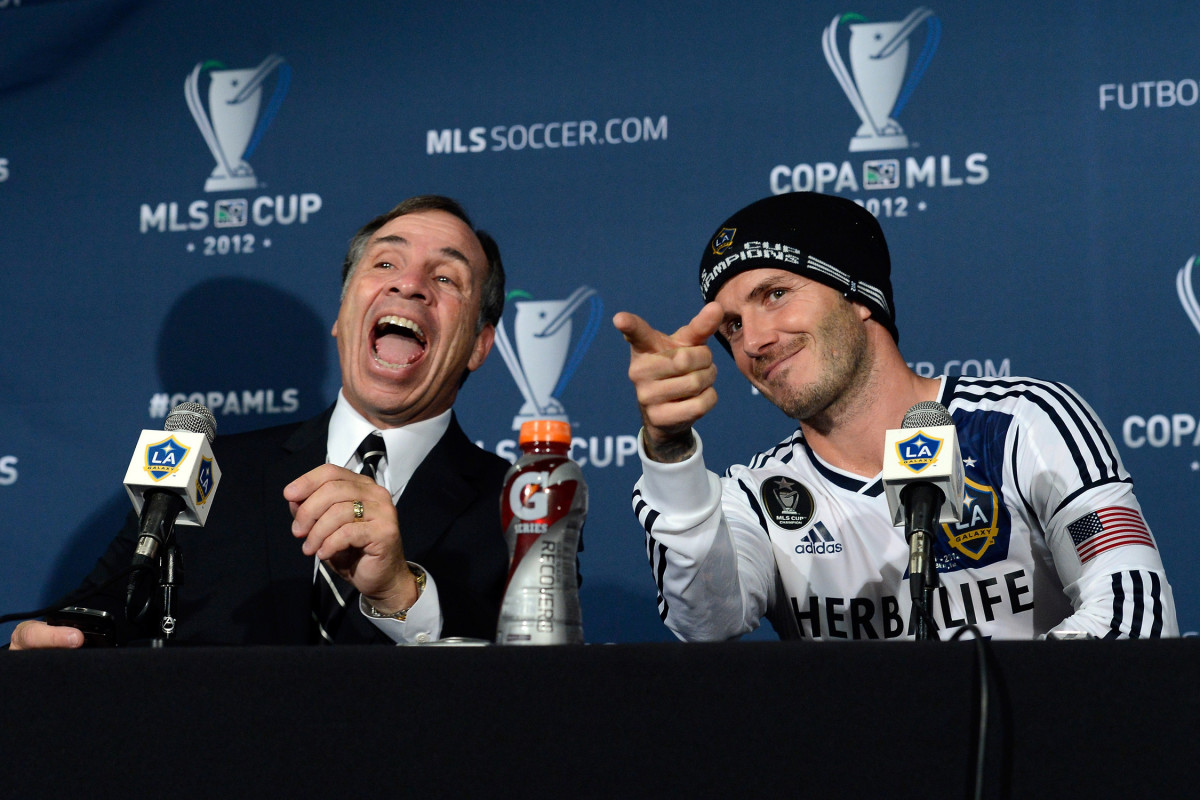
Bruce Arena and David Beckham share a light moment in the post-match press conference after the LA Galaxy beat the Houston Dynamo for a second straight season in the MLS Cup final, winning the 2012 title.
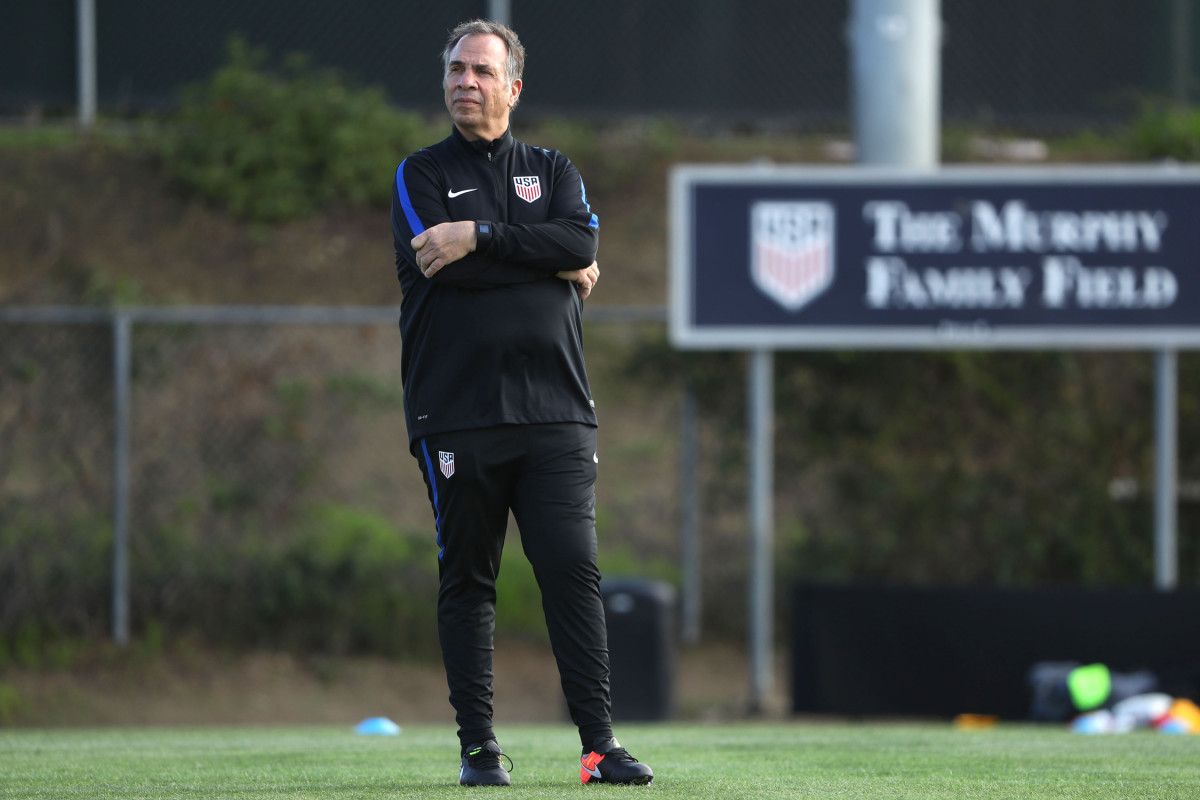
Bruce Arena returns to lead the U.S. men's national team, hired as Jurgen Klinsmann's replacement following a pair of World Cup qualifying losses in November 2016.
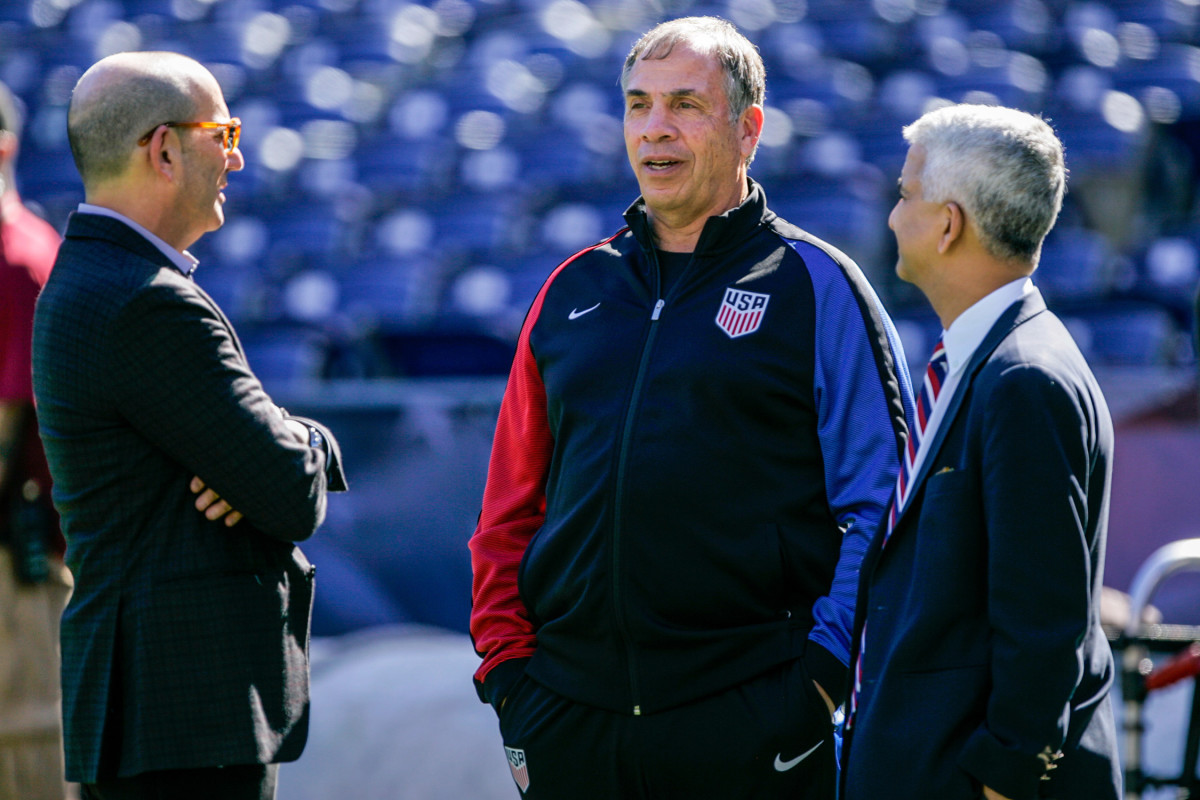
Bruce Arena chats with MLS commissioner Don Garber and U.S. Soccer president Sunil Gulati prior to his first match of his second stint with the U.S. men's national team, a friendly vs. Serbia in San Diego in January 2017.
On the day before a U.S. home game (and in Mexico this week when a U.S. Soccer rights-holder broadcasts the game), Arena will meet with the broadcast team from federation rights-holder Fox Sports or ESPN. With the stipulation that no information comes out until the game itself, Arena will answer their questions and provide background to help prepare the broadcasters. That usually includes giving them his U.S. starting lineup. That allows Fox Sports, Thursday’s broadcaster, to prepare lineup graphics and talking points ahead of time.
But with that sharing comes a vow from the broadcasters not to reveal the lineup to anyone.
“An important part of the relationship with the broadcast partners is trust,” says Kammarman, who has been with U.S. Soccer since 2001. “It’s something that’s earned, but also can be lost.”
Arena is most certainly right when he says that the media has changed more than he has since his first U.S. tenure. Take SI, for example. Back in the early 2000s, when the magazine still did a lot of news coverage, I would often be asked to write an Inside Soccer story off a U.S. game that wouldn’t appear publicly until five days after the game. Usually, Arena would meet up with me at the team’s hotel bar after the game over Michelob Ultras and provide information that didn’t come up in the postgame press conference.
That story would then contain some unique material a few days later. These days, SI magazine does very little news coverage, while and I’ll write two stories off a U.S. game for SI.com: A piece filed on the final whistle and a postgame column based on Arena’s press conference and player interviews in the mixed zone.
What is the mixed zone, you ask? Well, it’s something you see at the Olympics and at international soccer events, where locker rooms aren’t open to the media after games. Instead, there’s an area between the locker room and the team bus where the players walk through and can speak (or choose not to speak) to the media, which stands on the other side of shoulder-high barriers. It’s not exactly conducive to probing interviews, but at least it provides an opportunity to speak to the players.
As Dempsey nears USMNT history, high-scoring peers marvel at his unique career
Over the years, media members develop mixed-zone strategies to get what they’re looking for quote-wise, but it can get kind of crazy when you’re at a World Cup jockeying for position. One of the most unique mixed-zone strategies I’ve ever seen came at World Cup 2006, when an Italian media outlet had an attractive woman get the attention of players, then replaced her with an unattractive man to ask the players questions once they had stopped.
You never know what you might be exposed to covering soccer around the world. The first time I ever used high-speed Internet was at World Cup 2002 in South Korea, which has always been far ahead of the U.S. in Internet technology. And the first time I ever became aware of Google was in 2001, when interviewing Arena at his house in the Washington, D.C., area and he Googled "David Régis" to see how he had played that weekend in Europe.
When I told that story to Arena this week, he smirked. “The fact that I have anything to do with advancing technology to a person is absolutely amazing,” he said, “since I’m struggling to turn on my computer every day.”
Arena himself says he’s a media consumer.
“I like to follow the news media, especially since Donald Trump has become president,” he says. “I find it amazingly interesting. I get up every morning between 5 and 5:30 a.m. and watch CNN.”
Fox plans all-American 2018 World Cup lead broadcast crew: Strong, Donovan, Holden
He also says he reads some of the soccer media, though listening to podcasts isn’t his thing.
“I think the sports media is nothing close to what the news media is today, in terms of politics,” he says. “Watching shows on cable networks that are to the left, to the right and really never tell an accurate story is disgraceful, I think. I can’t ever say that about sports, but I’m sure we’ll get there one day.”
Until that day comes, Arena seems to enjoy the back-and-forth with the U.S. soccer media, knowing that if he loses games he’ll be criticized. So far, Arena hasn’t blacklisted any media members from one-on-one interviews in the way of his predecessor, Jurgen Klinsmann, who ended up trying to circumvent the media by doing his own videos and distributing them through U.S. Soccer.
“With Bruce, it’s been great so far, because he’s really open to a lot of our ideas," says Buethe, who has been with U.S. Soccer since 2003. "As a starting point, after the decision was made to hire Bruce we had a quick initial conversation on the phone, and he said, ‘Whatever you need, let me know and I’ll be there.’ That’s really been the case since day one. He’s been very open to our ideas, whether that’s providing access for outside media or for our internal content team which helps us tell the story of the team and the players.”
Becoming USMNT's first-choice left back? A reality, not a dream, for Jorge Villafaña
Kammarman notes that the number of reporters covering the USMNT has grown considerably. “Now we go to Mexico and we have 50 reporters going,” he says. That means it’s harder for reporters to get to build relationships with the team and the communications staff.
“Most of the people who cover the national team spend very little time around the national team,” he adds. “There are reasons for that. There’s budgets, and different outlets have different abilities to invest in those things. But it does make a difference in how we get covered. So our ability to be proactive and be out in front of things is more important than it was before.”
Kammarman has been working with Arena going back to their days together at D.C. United in the late 1990s. They sometimes sound like an old married couple. In describing how he deals with media requests, Arena pointed to Kammarman on Wednesday and said: “They tell me what they’d like me to do. I tell him he’s an a—hole most of the time, and then I basically do everything he asks me to do.”
Arena’s press officer laughed and knowingly shook his head. It would have made for a fun tweet on the imaginary unvarnished Bruce Arena Twitter account.
